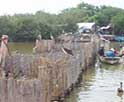Why Are Cetacean Strandings Increasing Globally?
Rising Whale and Dolphin Deaths on Beaches: Causes and Impacts
Reading time : 1 minute,
Discovery Chepe Id-689-ECO
Published in
05-06-2025

Photo: Benjamin Elliott
In recent years, reports of whale and dolphin strandings on beaches across the globe have surged dramatically. These tragic events not only alarm marine biologists but also raise questions about the health of our oceans and the impacts of human activity on marine ecosystems.
What Is a Cetacean Stranding?
A cetacean stranding refers to an event where whales, dolphins, or porpoises end up on the shore, either alive or dead. While some strandings occur naturally due to illness or old age, the growing frequency suggests deeper environmental and anthropogenic causes.

The Growing Problem of Dead Whales and Dolphins on World Beaches
Photo: PROFEPA MEXICO
Major Causes Behind the Increase
Environmental Pollution: Toxic chemicals, plastic waste, and oil spills disrupt marine life and may impair the navigation systems of cetaceans, leading to strandings. Microplastics and mercury poisoning have been found in the tissues of many stranded animals. Learn more at National Geographic - Ocean Pollution.
Noise Pollution: Sonar from military vessels, shipping traffic, and offshore drilling creates intense underwater noise that can disorient whales and dolphins, interfering with their echolocation abilities. This often drives them toward shallow waters where they become stranded. A detailed analysis is available from Oceans Initiative.
Climate Change: Rising ocean temperatures and changing currents affect the migration patterns and food availability for cetaceans. When food sources move closer to shore, whales and dolphins may follow sometimes fatally. For example, shifting fish populations due to warming waters have led to more coastal foraging behavior.
Human Activities and Fishing: Fishing gear entanglement and bycatch are leading causes of cetacean injuries and death. Additionally, increased coastal development and tourism can disrupt natural habitats. Many cetaceans suffer internal injuries or stress from high-speed boats and jet skis.
Illness and Disease: Certain viruses and bacterial infections have also been linked to mass strandings. For example, morbillivirus outbreaks have decimated dolphin populations in some regions.
Are We Doing Enough?
Although rescue efforts have improved, long-term solutions require global cooperation in reducing pollution, regulating naval exercises, enforcing responsible fishing practices, and combating climate change. Organizations like Whale and Dolphin Conservation and IFAW are actively working to protect cetaceans and their habitats.
The increasing frequency of cetacean strandings is a stark warning of oceanic distress. By addressing the root causes -many of which are human-driven- we have the chance to preserve the lives of these intelligent marine mammals and restore balance to marine ecosystems.
See Also
Discovery Chepe
Most read...














